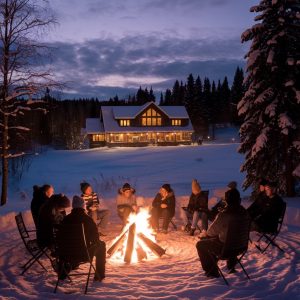
What is a BTU?
A British Thermal Unit (BTU) is a standard unit of heat measurement. Specifically, it represents the amount of heat required to raise the temperature of one pound of water by one degree Fahrenheit. In the context of firewood, BTU ratings indicate the potential heat output when a particular type of wood is burned. Higher BTU values signify greater heat production, which is crucial for tasks like home heating. Alberta firewood BTU guide charts will give you the amount of energy per cord of wood for some of the most common firewood species in Alberta. A cord is 128 cubic feet of split wood tightly stacked.
Factors Influencing BTU Ratings in Firewood
Several factors affect the BTU ratings of firewood:
- Wood Species: Different species have varying densities and compositions, leading to differences in energy content.
- Moisture Content: Seasoned (properly dried) wood has a lower moisture content, allowing it to burn more efficiently and produce more heat.
- Wood Density: Denser woods generally have higher BTU ratings because they contain more combustible material per unit volume.
Variations in BTU Charts
It’s common to encounter discrepancies in BTU charts for the same wood species. These variations can arise due to several factors:
- Measurement Conditions: Differences in how moisture content is measured or reported can lead to varying BTU values.
- Regional Differences: Climate and soil conditions can affect the density and growth rate of trees, influencing their energy content.
- Data Sources: BTU values may be derived from different studies or testing methods, leading to inconsistencies.
Firewood BTU Chart
Below is a chart detailing the approximate heat output of various tree species commonly used for firewood in Alberta:
| Tree Species | Approximate Heat Output (Million BTUs per Cord) |
|---|---|
| White Birch (Betula papyrifera) | 20.0 |
| Tamarack (Larix laricina) | 20.8 |
| Quaking Aspen (Populus tremuloides) | 18.0 |
| Balsam Poplar (Populus balsamifera) | 17.5 |
| White Spruce (Picea glauca) | 15.9 |
| Lodgepole Pine (Pinus contorta) | 15.3 |
Selecting the Right Firewood for Your Needs
Choosing the appropriate firewood in Alberta depends on your specific requirements:
- Home Heating: For sustained heat, especially during cold seasons, opt for woods with higher BTU ratings. Tamarack and White Birch are excellent choices due to their high energy content, ensuring longer burn times and efficient heating.
- Camping: When portability and ease of ignition are priorities, consider lighter woods that still provide adequate warmth. Quaking Aspen and Balsam Poplar are suitable for campfires, as they are easier to handle and ignite, making them ideal for cooking and short-duration fires.
- Backyard Fires: For recreational fires where ambiance is key, woods that produce pleasant aromas and visually appealing flames are desirable. White Spruce and Lodgepole Pine offer moderate heat and create a cozy atmosphere, perfect for social gatherings.
Economic Considerations
The cost and availability of firewood can vary based on region and demand. While high BTU woods like Tamarack may offer superior heat output, they might also be more expensive or less readily available. Balancing BTU ratings with cost and accessibility is crucial. For instance, if Quaking Aspen is abundant and affordable in your area, it might be a practical choice for both heating and recreational use, despite its slightly lower BTU rating.
Conclusion
Understanding BTU ratings and their implications is vital for selecting the right firewood for your specific needs. By considering factors such as intended use, wood species, and economic aspects, you can make informed decisions that enhance efficiency, comfort, and enjoyment, whether you’re heating your home or enjoying a campfire under the stars.





